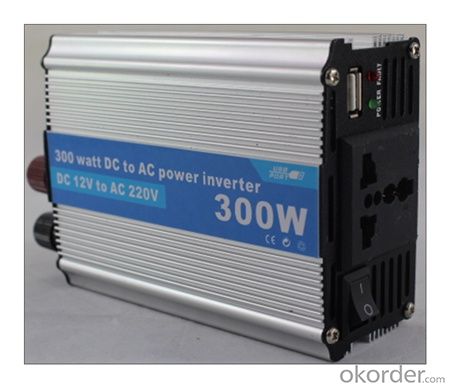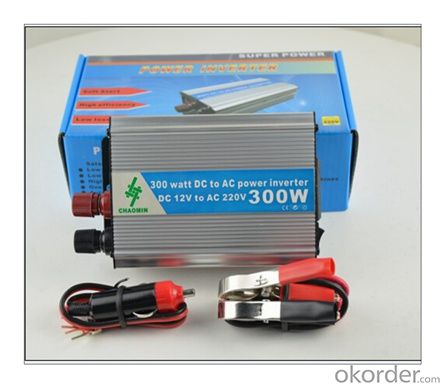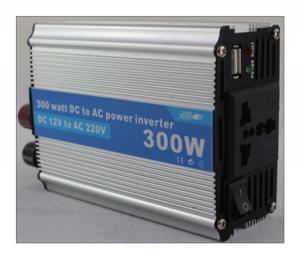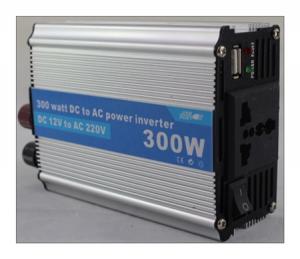Solar Charging Hight Quality Useful Discharging Controller 300W
- Loading Port:
- China main port
- Payment Terms:
- TT or LC
- Min Order Qty:
- 100 unit
- Supply Capability:
- 10000 unit/month
OKorder Service Pledge
OKorder Financial Service
You Might Also Like
1, Product desciption
Inverter circuits designed to produce a variable output voltage range are often used within motor speed controllers.
The DC power for the inverter section can be derived from a normal AC wall outlet or some other source. Control and feedback circuitry is used to adjust the final output of the inverter section which will ultimately determine the speed of the motor operating under its mechanical load.
Motor speed control needs are numerous and include things like: industrial motor driven equipment, electric vehicles, rail transport systems, and power tools. (See related: variable-frequency drive ) Switching states are developed for positive, negative and zero voltages as per the patterns given in the switching Table.
The generated gate pulses are given to each switch in accordance with the developed pattern and thus the output is obtained.
2, Features of the product
Inverters convert low frequency main AC power to higher frequency for use in induction heating.
To do this, AC power is first rectified to provide DC power. The inverter then changes the DC power to high frequency AC power. Due to the reduction in the number of DC Sources employed, the structure becomes more reliable and the output voltage has higher resolution due to an increase in the number of steps so that the reference sinusoidal voltage can be better achieved.
This configuration has recently become very popular in AC power supply and adjustable speed drive applications. This new inverter can avoid extra clamping diodes or voltage balancing capacitors. There are three kinds of level shifted modulation techniques, namely:
The first thing to figure out is the length of road in need of street lights.
This can be a small entrance road only a couple hundred of feet long to miles of streets through an area. Does the area currently have any type of lighting available.
What is the reason for needing street lights in this area
Is the electrical grid already nearby or would you need to call in the power company to bring in electrical lines.
If the electric needs to be brought to the area, how much is this going to cost? Depending on how far the grid electric is from the location of the needed lighting, this can be quite expensive.
How much lighting is needed on the street? Do the lights need to be dark sky compliant.
Do the street lights need to run from dusk to dawn or for only a specified number of hours at night.
Are the street lights able to dim in the middle of the night and still provide enough lighting.
These questions need to be answered before you can decide on how many lights you will need to complete the project.
3, Product Image


4, Detailed Specification
Specification:
Model | Tracer |
Rated system voltage | 12/24V auto work |
Rated battery current | 40A |
Rated load current | 20A |
Max.battery voltage | 32V |
Max.PV open circuit voltage | 100VDC |
Max.PV input power | 12V 500W, 24V 1000W |
Self-consumption | <10mA(24V) |
Charge Circuit Voltage Drop | ≤0.26V |
Discharge Circuit Voltage Drop | ≤0.15V |
Communication | TTL232 / 8 pin RJ45 |
Temp.compensation | -5mV/℃/2V |
Working temperature | -35℃~+55℃ |
Storage temperature range | -35℃~+80℃ |
Humidity | 10%-90% NC |
Enclosure | IP30 |
Altitude | ≤3000m |
Dimension | 242mm x 169mm x 91mm |
Mounting holes | 180mm x 160mm |
Mounting hole size | Φ5 |
Terminal | 25mm2 |
Weight | 2.05kg |
- Q:Can a solar controller be used with solar tracking systems?
- Yes, a solar controller can be used with solar tracking systems. The solar controller is responsible for regulating the charging and discharging of the batteries in a solar power system. It ensures that the battery is charged efficiently and protects it from overcharging or over-discharging. In the case of solar tracking systems, the solar controller can also be used to control the movement of the solar panels to track the sun's position. This allows for optimal energy generation by constantly adjusting the angle of the panels to capture maximum sunlight. So, a solar controller is an essential component that can be used in conjunction with solar tracking systems to enhance their performance.
- Q:What is the maximum number of load control modes supported by a solar controller?
- The maximum number of load control modes supported by a solar controller can vary depending on the specific model and brand. However, most modern solar controllers typically support around 4 to 5 load control modes.
- Q:Can a solar controller be used with a solar-powered residential building?
- Yes, a solar controller can be used with a solar-powered residential building. A solar controller is an essential component of a solar power system that helps regulate the charging and discharging of batteries, ensuring efficient energy management. It helps optimize the performance of solar panels by preventing overcharging and protecting the battery from damage. In a residential building, a solar controller would play a crucial role in maintaining the stability and reliability of the solar power system, making it an important component for any solar-powered residential building.
- Q:What is the role of a solar controller in preventing battery over-discharge?
- The role of a solar controller in preventing battery over-discharge is to monitor the energy levels of the battery and regulate the charging and discharging process. It ensures that the battery is not drained beyond a certain threshold, which helps to prolong its lifespan and prevent irreversible damage. The solar controller acts as a safeguard by disconnecting the load from the battery when it reaches a low voltage, preventing over-discharge and maintaining the battery's overall health.
- Q:How do I protect a solar controller from electromagnetic interference?
- To protect a solar controller from electromagnetic interference (EMI), you can follow a few measures: 1. Shielding: Ensure the solar controller is housed in a metal or conductive enclosure that acts as a shield against EMI. This can help prevent external electromagnetic signals from interfering with the controller's functioning. 2. Grounding: Properly ground both the solar controller and any connected equipment. Grounding helps divert unwanted electrical currents and reduces the risk of EMI affecting the controller. 3. Cable Management: Keep the cables connecting the solar controller well organized and away from potential sources of electromagnetic interference, such as power lines, motors, or other electrical devices. Use shielded cables wherever possible to minimize EMI. 4. Filtering: Install EMI filters on the power supply lines connected to the solar controller. These filters can help suppress unwanted electromagnetic noise and ensure stable operation. 5. Distance: Maintain a safe distance between the solar controller and any potential sources of EMI. If feasible, physically separate the controller from devices that may generate significant electromagnetic interference. By implementing these steps, you can enhance the protection of your solar controller against electromagnetic interference, ensuring its optimal performance and longevity.
- Q:Can a solar controller be used with solar panels that are connected to a solar water pump?
- Solar panels connected to a solar water pump can indeed use a solar controller. The solar controller is a necessary part of a solar power system, as it regulates the voltage and current generated by the solar panels. This ensures efficient energy usage and proper distribution to connected devices. With the addition of a solar water pump, the solar controller optimizes power output and safeguards against overvoltage or overcurrent issues. It also monitors battery status, if applicable, and ensures appropriate charging and discharging cycles. All in all, a solar controller plays a vital role in managing and controlling the energy flow within a solar-powered water pump system, guaranteeing its optimal operation and durability.
- Q:Can a solar controller be used in a solar-powered deep-sea mining system?
- Yes, a solar controller can be used in a solar-powered deep-sea mining system. A solar controller is responsible for regulating and optimizing the charging process of solar panels, ensuring proper power management and protection. In a deep-sea mining system, where sunlight may be limited, a solar controller would be essential to efficiently harness and utilize the available solar energy for powering the system's operations.
- Q:How does a solar controller regulate the charging current?
- The charging current of the solar panel and battery is regulated by a solar controller, which monitors the voltage and current levels. Its purpose is to prevent overcharging of the battery by limiting the current flow when the battery reaches its maximum voltage. To achieve this regulation, the controller employs either pulse width modulation (PWM) or maximum power point tracking (MPPT) techniques. In a PWM solar controller, the controller controls the average charging current by rapidly turning the solar panel's current on and off. When the battery voltage is low, the controller allows a maximum charging current, which gradually decreases as the battery voltage rises. This prevents overcharging and damage to the battery. On the other hand, an MPPT solar controller utilizes a more advanced algorithm to continuously track the maximum power point (MPP) of the solar panel. The MPP represents the optimal voltage and current combination at which the solar panel can deliver its maximum power output. The controller adjusts the charging current accordingly to ensure that the panel operates at its MPP, resulting in maximum power transfer to the battery. Both PWM and MPPT controllers are efficient in regulating the charging current, thus preventing overcharging and extending the battery's lifespan. The choice between the two depends on factors such as the characteristics of the solar panel, battery type, and system requirements.
- Q:Can a solar controller be used in a solar-powered lunar base?
- Yes, a solar controller can be used in a solar-powered lunar base. Solar controllers are used to regulate and optimize the charging of batteries from solar panels. In a lunar base, solar panels would be the primary source of power generation, and a solar controller would play a crucial role in efficiently managing the power generated and storing it in batteries for use during periods of low or no sunlight.
- Q:Can a solar controller be used with solar-powered outdoor recreational equipment?
- Yes, a solar controller can be used with solar-powered outdoor recreational equipment. A solar controller regulates the voltage and current from the solar panels to ensure proper charging and protection of the equipment's batteries. It helps maximize the efficiency and lifespan of the solar-powered equipment by preventing overcharging or damage to the batteries.
1. Manufacturer Overview |
|
|---|---|
| Location | |
| Year Established | |
| Annual Output Value | |
| Main Markets | |
| Company Certifications | |
2. Manufacturer Certificates |
|
|---|---|
| a) Certification Name | |
| Range | |
| Reference | |
| Validity Period | |
3. Manufacturer Capability |
|
|---|---|
| a)Trade Capacity | |
| Nearest Port | |
| Export Percentage | |
| No.of Employees in Trade Department | |
| Language Spoken: | |
| b)Factory Information | |
| Factory Size: | |
| No. of Production Lines | |
| Contract Manufacturing | |
| Product Price Range | |
Send your message to us
Solar Charging Hight Quality Useful Discharging Controller 300W
- Loading Port:
- China main port
- Payment Terms:
- TT or LC
- Min Order Qty:
- 100 unit
- Supply Capability:
- 10000 unit/month
OKorder Service Pledge
OKorder Financial Service
Similar products
New products
Hot products
Hot Searches
Related keywords































